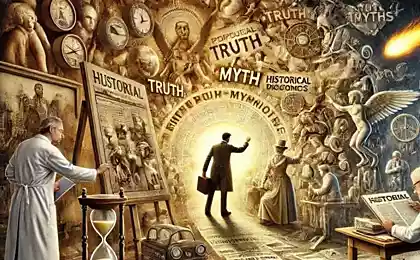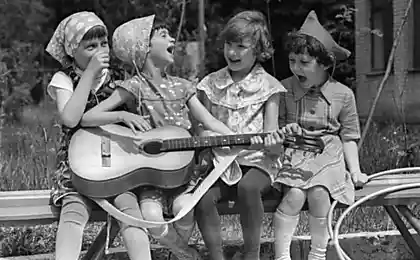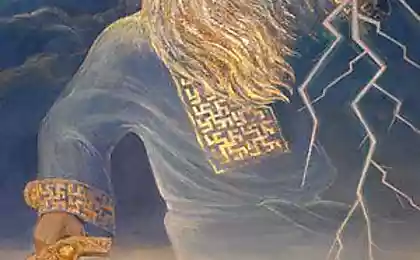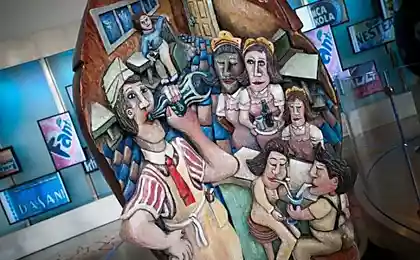209
8 myths that children of the 80s believed in
Today, even the most naive schoolboy will not believe that for the anniversary ruble you can get a new car, and a kilogram of dried mosquitoes can significantly increase the level of personal well-being. But they did in the '80s.
Chewing gum imported for the first time was able to try the lucky ones who took part in 1957 in the VI Festival of Youth and Students. In the 80s, gum in the children’s environment became the subject of bargaining and “speculation”. The owner of the wrapper from “Turbo”, which appeared in the late 80s, automatically “rised” in the eyes of peers. What can we say about those who could effectively remove a package of gum from their pocket and offer it to friends. At this time, there were rumors among schoolchildren that the still dormant “enemies” were inventing new sabotages to harm the Soviet pioneers, for which blades were placed in some gums. Many children were so “permeated” by these stories that, as adults, they continued to break the gum plate into two halves before using it.
In 1965, the first anniversary ruble was minted in the Soviet Union with a circulation of 60 million pieces. By itself, the amount of one ruble was already for a Soviet child wealth, let alone an unusual anniversary coin. In the 80s, Soviet children enthusiastically told their parents that there was a secret state organization that willingly exchanged the anniversary ruble for a real car. The reasons for the unprecedented generosity seemed very clear: the iron ruble was supposedly made of a miracle metal, which was relentlessly hunted by the Japanese and Americans. The metal was so secret that no one knew its exact name, as well as the name of the organization that exchanged rubles for cars.
In the 80s, there was a myth that if you charge a mysterious red film into a camera, the people in the photo will turn out without clothes. Of course, no one has ever seen such a film, but everyone wanted to get it. The students, who were lucky enough to get a camera, took pictures of their classmates with the cry: “Now you are on red tape”, which drove the latter to hysterics. Of course, no one has ever seen the photos.
In the 80s, one of the first electronic games appeared in the USSR. Thousands of Soviet schoolchildren watched a wolf catch eggs on a black and white screen. Apparently, trying to somehow justify their fooling, while their peers are scouring the city in search of scrap metal and waste paper, the owners of the game said that if they manage to score a certain number of points, a chic Disney cartoon will be shown. Not computer-advanced older generations believed it was possible. The wolf really, when achieving a certain result, made some ridiculous body movements, but it was possible to call them a cartoon with a huge stretch.
Even scientists don’t seem to think about how much a mosquito weighs. But Soviet schoolchildren in the 80s often estimated how many blood-sucking insects you need to kill to collect a “herbarium” weighing a kilogram. The reason for finding a solution to such an unusual problem was the legend, according to which for a kilogram of dried mosquitoes gave something “super”. No one knew for sure. Sometimes it was a very large amount of money. The main problem, according to young naturalists, was that less than a kilogram was not taken, and the collection of an entomological collection of a given weight could take a lifetime.
The peak of karate popularity in the Soviet Union also fell in the 80s, despite numerous prohibitions. Boys willingly imitated fighters who defeated the crowd of opponents with almost bare hands. The cry of “Kiya!” and the traditional karate stand were known to almost every schoolboy. Sometimes “self-taught” “honed their skills” due to the “folk training system”. For example, if for a long time to rub the edge of the palm with a pencil grill, then you can later easily break bricks. There were two conditions that had to be met. First, the pencil must be Chinese. Second, you had to use up the whole slate. Needless to say, it was very difficult to get imported products in the 80s, and not many people had enough patience to perform the “exercise”. The most purposeful, however, brought it to the end, and often ended up in the hospital with fractures of fingers or wrists.
The brand new bicycle "Orlyonok" for many Soviet schoolchildren was only a dream. Thus was born a myth that promised “a fairy tale to come true.” If you collect mysterious figures that are not clear why were placed on one of the cardboard packs of cigarettes "Cosmos", you can become a happy owner of your own means of transportation. There were a huge number of variations of this legend: the figures could be found not only in packs of "Space", but in other cigarettes, and for the full combination was given not a bicycle, but an airgun. Whether anyone managed to collect all the numbers from 1 to 15, and where there was a miracle exchange – this history is silent, but the fact that the father’s packs of cigarettes were controlled and mercilessly tortured in search of magic numbers – a fact.
The consciousness of Soviet children was stirred by the myth-horror about a black tinted bus (or Volga) traveling through the expanses of the USSR. Allegedly, children were lured into it under various pretexts and taken away in an unknown direction. For what purpose is history silent? It was very easy to recognize the bus that killed millions: in its license plate there were two “S” and “D”, which stood for “Death to Soviet Children!” The instructive story once and for all discouraged obedient children from wanting to talk to strangers and even more so get into their car. In addition, many parents intimidated their children with stories about killer toys that could be found on the street. At home, toys “activated” and killed not only small owners, but also entire families. Bringing such finds home was strictly forbidden.
Source: mirfactov.com/
Chewing gum imported for the first time was able to try the lucky ones who took part in 1957 in the VI Festival of Youth and Students. In the 80s, gum in the children’s environment became the subject of bargaining and “speculation”. The owner of the wrapper from “Turbo”, which appeared in the late 80s, automatically “rised” in the eyes of peers. What can we say about those who could effectively remove a package of gum from their pocket and offer it to friends. At this time, there were rumors among schoolchildren that the still dormant “enemies” were inventing new sabotages to harm the Soviet pioneers, for which blades were placed in some gums. Many children were so “permeated” by these stories that, as adults, they continued to break the gum plate into two halves before using it.
In 1965, the first anniversary ruble was minted in the Soviet Union with a circulation of 60 million pieces. By itself, the amount of one ruble was already for a Soviet child wealth, let alone an unusual anniversary coin. In the 80s, Soviet children enthusiastically told their parents that there was a secret state organization that willingly exchanged the anniversary ruble for a real car. The reasons for the unprecedented generosity seemed very clear: the iron ruble was supposedly made of a miracle metal, which was relentlessly hunted by the Japanese and Americans. The metal was so secret that no one knew its exact name, as well as the name of the organization that exchanged rubles for cars.
In the 80s, there was a myth that if you charge a mysterious red film into a camera, the people in the photo will turn out without clothes. Of course, no one has ever seen such a film, but everyone wanted to get it. The students, who were lucky enough to get a camera, took pictures of their classmates with the cry: “Now you are on red tape”, which drove the latter to hysterics. Of course, no one has ever seen the photos.
In the 80s, one of the first electronic games appeared in the USSR. Thousands of Soviet schoolchildren watched a wolf catch eggs on a black and white screen. Apparently, trying to somehow justify their fooling, while their peers are scouring the city in search of scrap metal and waste paper, the owners of the game said that if they manage to score a certain number of points, a chic Disney cartoon will be shown. Not computer-advanced older generations believed it was possible. The wolf really, when achieving a certain result, made some ridiculous body movements, but it was possible to call them a cartoon with a huge stretch.
Even scientists don’t seem to think about how much a mosquito weighs. But Soviet schoolchildren in the 80s often estimated how many blood-sucking insects you need to kill to collect a “herbarium” weighing a kilogram. The reason for finding a solution to such an unusual problem was the legend, according to which for a kilogram of dried mosquitoes gave something “super”. No one knew for sure. Sometimes it was a very large amount of money. The main problem, according to young naturalists, was that less than a kilogram was not taken, and the collection of an entomological collection of a given weight could take a lifetime.
The peak of karate popularity in the Soviet Union also fell in the 80s, despite numerous prohibitions. Boys willingly imitated fighters who defeated the crowd of opponents with almost bare hands. The cry of “Kiya!” and the traditional karate stand were known to almost every schoolboy. Sometimes “self-taught” “honed their skills” due to the “folk training system”. For example, if for a long time to rub the edge of the palm with a pencil grill, then you can later easily break bricks. There were two conditions that had to be met. First, the pencil must be Chinese. Second, you had to use up the whole slate. Needless to say, it was very difficult to get imported products in the 80s, and not many people had enough patience to perform the “exercise”. The most purposeful, however, brought it to the end, and often ended up in the hospital with fractures of fingers or wrists.
The brand new bicycle "Orlyonok" for many Soviet schoolchildren was only a dream. Thus was born a myth that promised “a fairy tale to come true.” If you collect mysterious figures that are not clear why were placed on one of the cardboard packs of cigarettes "Cosmos", you can become a happy owner of your own means of transportation. There were a huge number of variations of this legend: the figures could be found not only in packs of "Space", but in other cigarettes, and for the full combination was given not a bicycle, but an airgun. Whether anyone managed to collect all the numbers from 1 to 15, and where there was a miracle exchange – this history is silent, but the fact that the father’s packs of cigarettes were controlled and mercilessly tortured in search of magic numbers – a fact.
The consciousness of Soviet children was stirred by the myth-horror about a black tinted bus (or Volga) traveling through the expanses of the USSR. Allegedly, children were lured into it under various pretexts and taken away in an unknown direction. For what purpose is history silent? It was very easy to recognize the bus that killed millions: in its license plate there were two “S” and “D”, which stood for “Death to Soviet Children!” The instructive story once and for all discouraged obedient children from wanting to talk to strangers and even more so get into their car. In addition, many parents intimidated their children with stories about killer toys that could be found on the street. At home, toys “activated” and killed not only small owners, but also entire families. Bringing such finds home was strictly forbidden.
Source: mirfactov.com/
























